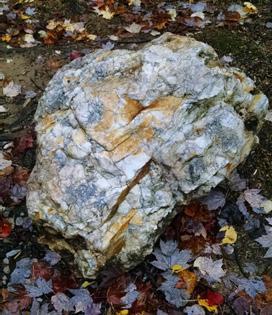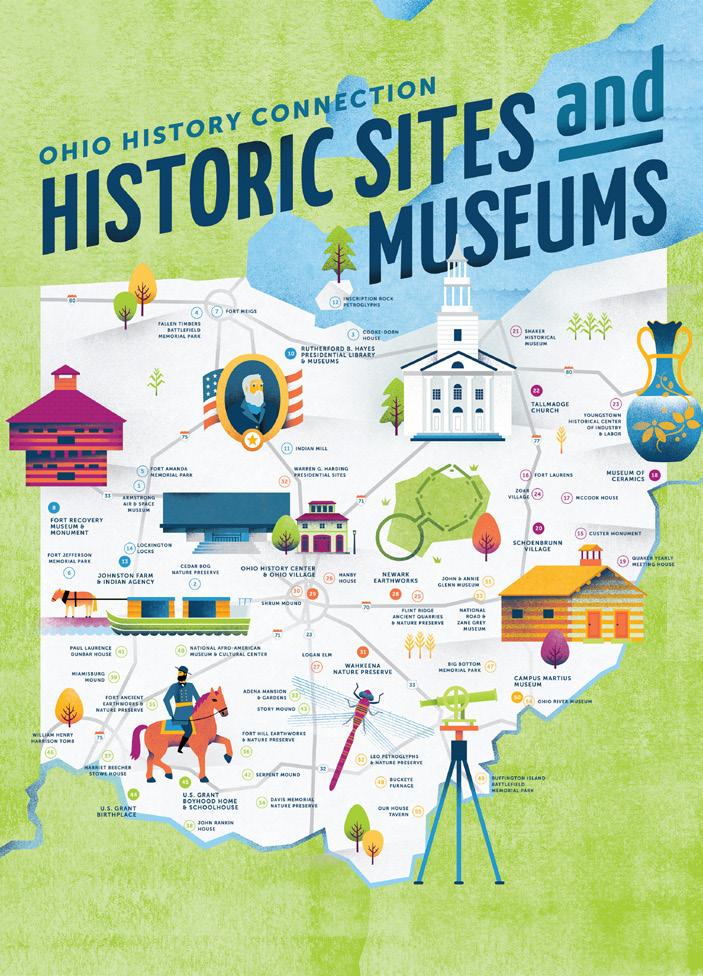
3 minute read
Four Outdoor NATURAL HISTORY SITES You Should Visit this Winter
+ OUR PICKS FOR A COFFEE OR HOT CHOCOLATE STOP FOR AFTER YOUR VISIT!
By Truda Shinker, Ohio History Connection Membership Manager
Cold weather hikes are a great way to shake the winter blues. Get bundled up and head out to one of these Ohio History Connection sites this winter to get out of the house, get some exercise and get a new perspective on our state’s incredible natural history. Then grab a coffee or hot chocolate to warm up before you head home!
We always advise that you call the site and coffee houses directly to verify opening days and hours before you head out on your road trip.
CEDAR BOG NATURE PRESERVE + THE DEPOT COFFEE HOUSE
Experience Ohio as it was over 10,000 years ago as you walk along a mile-long boardwalk through this 450-acre preserve in Urbana. Look for skunk cabbage in February (it blooms because it can thaw the ice and snow around it). A National Natural Landmark, Cedar Bog Nature Preserve is the largest and best example of a boreal and prairie fen complex in Ohio. Cedar Bog is home to 40% of Ohio’s rare species, in one location.
Cedar Bog offers a glimpse into what the landscape looked like during the waning Ice Age when it was home to mastodons, giant ground sloths and beavers the size of bears.
The nature center is closed during the winter, but the boardwalk is open daily from 10 a.m.-4 p.m.. Be sure to check hours in advance as the entire site is closed on certain dates throughout the winter for deer hunting season. For more information, check out ohiohistory.org/cedarbog. You can also call the site directly at 937.484.3744.
Grab a hot chocolate or coffee at The Depot Coffeehouse in Urbana!
FLINT RIDGE ANCIENT QUARRIES & NATURE PRESERVE + RIVER ROAD COFFEEHOUSE ON THE SQUARE
Hike trails through the 533-acre preserve and see ancient pits left by American Indians who came from the surrounding area to quarry flint. The unique rainbowcolored flint was used as an item of trade, tools and weapons.

Flint Ridge in Glenford is a nearly eightmile-long vein of high-quality flint located in Licking and Muskingum counties of eastern Ohio. Hundreds of quarry pits and workshop sites are scattered across more than 2,000 acres of ridge top in these Appalachian foothills. It has been called the “Great Indian Quarry of Ohio."
The museum is closed during the winter, but the trails are open year round. For more information, visit ohiohistory.org/flintridge.

Enjoy a warm treat at the River Road Coffeehouse on the Square in Newark!
FORT HILL EARTHWORKS & NATURE PRESERVE + THE DAILY GRIND
Fort Hill in Hillsboro has what many call the best hiking trails in the state, encompassing 1,300 acres in Highland County. You can hike to a stone and earthen-walled Hopewell hilltop enclosure at the top of Fort Hill. With a circumference of 1.5 miles, the earthwork has 33 gateways and, on the inside, a large ditch. Fort Hill’s hilltop earthworks are accessible only by hiking to the top. Two trails terminate at the enclosure.
The Fort Hill Education Center is open by appointment only, but the trails are open all daylight hours Monday-Sunday except for specific dates during deerhunting season in November and January each year. Please call the site manager at 800.283.8905 for more information. For general information about the site, visit ohiohistory.org/forthill.
Treat yourself to a hot drink at The Daily Grind in Hillsboro!
LEO PETROGLYPHS & NATURE PRESERVE + THE SPOT ON MAIN

Perched on a ridge just outside the village of Leo, Leo Petroglyph & Nature Preserve is a legacy of the American Indian peoples of ancient Ohio. Protected beneath the roof of a shelter house, a large flat sandstone slab preserves the traces of some of the most remarkable rock art in Ohio. The panel of petroglyphs includes between 37 figurative drawings ancient people cut into the sandstone outcrop. The exact age of the carvings is unknown, but based on the degree of weathering of the soft sandstone, the carvings are probably not more than 1,000 years old. The art is likely the work of the Fort Ancient culture.
A half-mile trail leads through a gorge and along unglaciated Mississippian sandstone cliffs that are 20–65 feet high. The trail follows a small intermittent tributary of Sour Run that runs through the gorge, before eventually draining into Little Salt Creek and then into the Scioto River near Richmond Dale.
The trails at Leo Petroglyphs are open during daylight hours Monday-Sunday. For more information, visit ohiohistory.org/leopetroglphs.
Take a break before you head home at The Spot on Main in Jackson!
TO READ MORE STORIES LIKE THIS, visit ohiohistory.org/blog

***Closed









